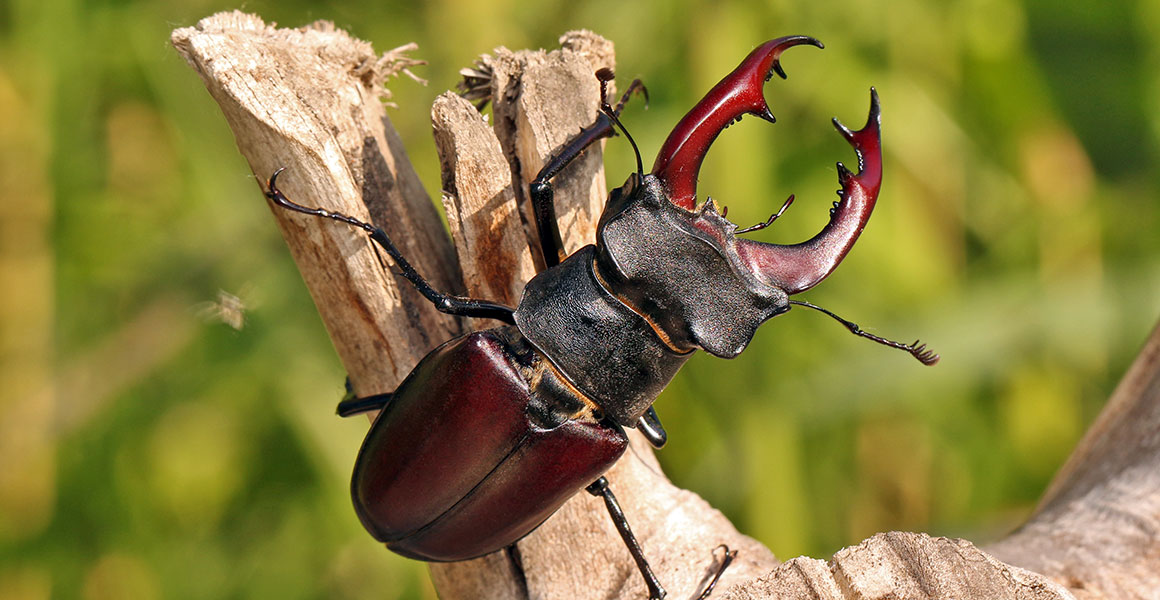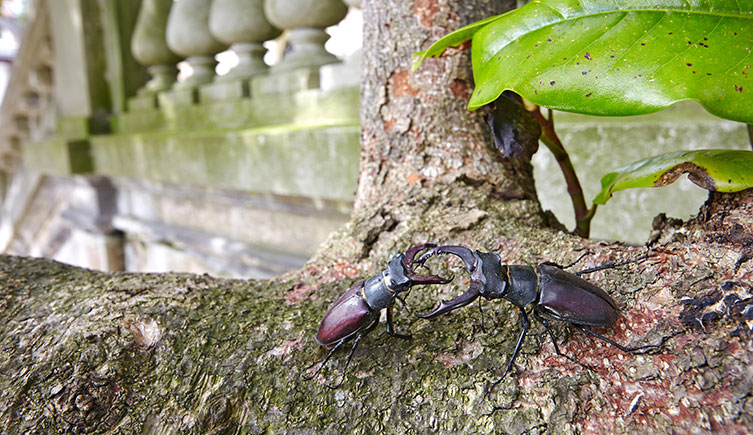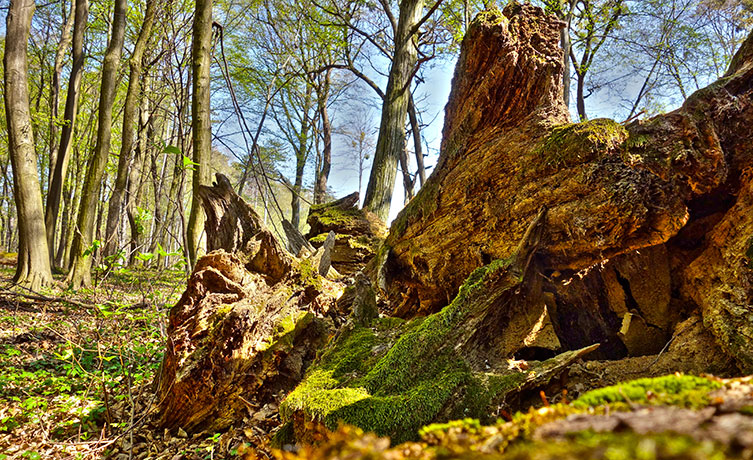Flying haphazardly through the air on a balmy summer day, the male stag beetle is in a hurry to find a mate. Find out how he puts his spectacular antler-like jaws to use, why this species needs protection and how you can help.

Stag beetles (Lucanus cervus) are the largest beetle not just in the UK but in Europe. The males can measure nearly 8cm long. © Achkin/ Shutterstock.com
Stag beetle populations are declining across much of Europe, but did you know London and the surrounding Thames Valley area are hotspots for this magnificent, rare beetle?
Max Barclay, Senior Curator in Charge of the Museum's beetle collection, says:
'Stag beetles are rare and threatened throughout northern Europe and the populations in the Thames Valley are some of the largest in the world. London is a particular stronghold.
'We're lucky that these beautiful and interesting creatures inhabit our city parks and gardens. We should make these gentle giants welcome and be proud to have them sharing our living spaces.'

After decades of population declines, stag beetles (Lucanus cervus) are rare in the UK. London is a particular stronghold of the species. © Nature Picture Library/ Alamy Stock Photo
Read on to find out more about this charismatic beetle's lifestyle, impressive stats and why it needs our help.
Stag beetle fast facts
- Alternative common names: European stag beetle, greater stag beetle
- Scientific name: Lucanus cervus
- Length, including mandibles/jaws: males 35-75mm long, females 30-50mm long
- Weight: 2-6 grams
- Average lifespan: 3-7 years
- UK status: Native
- UK population: Unknown (you can help scientists find out)
- UK conservation status: Partially protected
- IUCN Red List category: Near Threatened on the European Red List of Saproxylic Beetles (PDF)
Largest beetle in Europe: just how big can a stag beetle grow?
One of the most noteworthy things about stag beetles is their size. Male stag beetles measure up to 7.5 centimetres long when their impressive jaws are taken into account, making this species the largest beetle in the UK and in fact the whole of Europe.
How do other contenders measure up?
In the UK, the stag beetle beats its next rival for the biggest beetle record by a few centimetres. The great diving beetle (Dytiscus marginalis), a voracious predator that lives in ponds, can reach about three centimetres long. Although it is aquatic, this beetle sometimes leaves the water and flies off to settle in a new pond.
The European rhinoceros beetle (Oryctes nasicornis) can be nearly six centimetres long, although two to four centimetres is more usual. One was discovered in the UK for the first time in 2013, in a Worcestershire garden. A lack of further sightings suggests the individual was an escaped pet or was accidentally imported on a plant from Europe. There is no evidence that a population has established itself in the wild in the UK.
Another contender for the title of Europe's biggest beetle is the great capricorn beetle (Cerambyx cerdo), which has a body length of four to five centimetres, excluding the antennae.
The size of an adult stag beetle is influenced by the quality and amount of food it had access to as a larva. The smallest males are about four centimetres long. Even so, male stag beetles are usually considerably larger than female ones, which can be as little as three centimetres long.

Female stag beetles lack large mandibles (jaws) and can be half the size of males © WildMedia/ Shutterstock.com
The size of stag beetle larvae is even more impressive than the adult beetles. They can grow to around 11 centimetres long.
What do the male stag beetles use their massive mandibles for?
Male stag beetles use their large, antler-like jaws to battle each other for access to females during breeding season, much like a male deer uses its antlers. This is also where the beetle gets its name.
Senior beetle curator Beulah Garner says, 'Male stag beetles use their magnificent mandibles as a warning signal to other males, raising them in a defensive or aggressive posture to fight off a contender.
'These beetles are skilful wrestlers and can even stand up on their hind legs to throw an opponent.'
The male beetles spend a lot of time and effort dislodging their opponent from where it clings. The more similar the jaw size of the rivals, the longer the battles last. The largest individual almost always wins.

Battles between male stag beetles can be quite dramatic © WildMedia/ Shutterstock.com
Beulah adds, 'The male beetles also use their impressive antlers as part of their courtship display, circling the female with them raised and wide open.'
What do stag beetles eat?
Adult stag beetles don't eat, but they do drink sweet fluids such as tree sap and the liquid from decomposing fruit. They mostly rely on the energy stores they built up as a larva.
Stag beetle larvae feed on dead wood, using their sharp jaws to scrape the fibrous surface for splinters. Wood infested with white rot is a particular favourite as it helps to decompose the wood. The larvae also digest any fungi and other organisms in the wood.
The larvae seem to prefer the wood of oak trees but will also eat other broad-leaved species such as beech, willow, ash, elm, sycamore, lime, hornbeam, horse chestnut, apple, cherry and some garden varieties. They tend to avoid coniferous species such as fir and pine trees.
Since stag beetles only feed on dead wood, they don't pose a risk to living trees or shrubs.

Although it is the massive adult male beetles that catch our attention, most of a stag beetle's life is spent underground as a larva eating dead wood © Carl Mckie/ Shutterstock.com
Where do stag beetles live?
In the UK, stag beetles mainly live in southeast England, although they are locally common along parts of the southwest coast and in the Severn Valley. They are most abundant around the Thames Valley, the New Forest in Hampshire and down to the south coast. The species is also found in central and southern parts of Europe.
Stag beetles' natural habitat is woodland, but they can also be found in hedgerows, traditional orchards and urban areas, particularly in parks and gardens with a lot of dead wood. London supports a nationally significant population.

In southeast England and other parts of Europe where the species is found, stag beetles can be spotted in and around urban parks and gardens that contain plenty of dead wood © BIOSPHOTO/ Alamy Stock Photo
The females find it easier to dig down into light soil to lay their eggs. Areas with chalky soil, such as the north and south downs, have fewer stag beetles.
Why is London a hotspot for stag beetles?
Max explains, 'Stag beetles need warmth and the climate of southern England is more suitable for them than the rest of the country.
'They like Sun-exposed dead wood, so individual trees and stumps in gardens and parks may provide better, warmer conditions for the larvae to develop in than the shaded trunks and stumps of a dense forest.'
Across London, stag beetle beetles are far more common in the south and west. Central London lacks suitable habitat, but researchers don't yet know why the species isn't more abundant in north and east London.
Epping Forest and neighbouring areas in northeast London are an exception to this pattern. The forest is designated a European Special Area for Conservation, partly due to the presence of stag beetles. So are Richmond Park, Wimbledon Common and Putney Heath.

Richmond Park in southwest London - popular with visitors for its deer, including the male stags and bucks - is an important stag beetle site © jgolby/ Shutterstock.com
How long do stag beetles live?
Stag beetles live between three and seven years, on average. The vast majority of this time is spent as a larva underground, creating tunnels through the rotting wood they feed on.
Females lay their eggs - possibly as many as 30 - in dead wood or nearby soil. The eggs hatch after about three weeks and the larvae then spend several years feeding on decaying wood.
Beulah explains, 'How long the beetles spend underground in their larval state depends on the temperature and the nutritional content of the wood.
'The more decomposed the wood is, the less energy the larva has to spend on breaking up the wood fibre and the more fungi and other organisms are available to eat, so the larva can develop more quickly.'
Stag beetles undergo complete metamorphosis to transform from their larval to adult form. Pupation takes about six weeks and begins in the final autumn of the beetle's life cycle. The transformed adult leaves the pupa but remains underground until the following May or June when they emerge from the soil beneath logs and tree stumps. Adult males emerge first.
Max adds, 'The adults stay underground until the temperature reaches a certain consistent level. They usually burrow their way to the surface after warm summer rains when the ground is softer.'
Once above ground, adults only survive for a few weeks and their sole purpose is to mate. Males mate multiple times.

A male stag beetle tries to impress a female with his courtship display © WildMedia/ Shutterstock.com
How and when to see a stag beetle
Adult stag beetles are crepuscular, which means they are active mainly at twilight.
The males can generally be seen from mid-May to late July, especially on hot and humid summer evenings an hour or two before dusk, when they fly about looking for females. They can be attracted to light.
In urban areas with stag beetle populations, you may also notice them walking on the ground, particularly along roads and pavements, as they appear to be attracted to these warm surfaces.

Male stag beetles have only a matter of weeks in summer to find a mate and there can be stiff competition © Nature Photographers Ltd/ Alamy Stock Photo
Due to their lifestyle, you're most likely to see stag beetles near areas of deciduous woodland or parkland with big, old trees and gardens containing plenty of dead wood. If you live in an area with stag beetles, you could increase your chances of an encounter by keeping dead wood in your garden.
Adult stag beetles generally die soon after mating and egg laying, usually by August.
You're unlikely to see a stag beetle larva unless you accidentally dig one up. If you do, try to put it back exactly where you found it. If that's not possible, bury it in a safe place with as much of the rotting wood from its original location as possible.
Do female stag beetles fly?
Female stag beetles are capable of flight. Like most other beetles they have flight wings hidden under hardened outer wings. However, you're far more likely to see them on the ground looking for a suitable spot to lay their eggs.
They tend to return to the place where they hatched to lay their own brood, often even the same piece of wood. Max adds, 'The females don't usually move very far unless they have to.'
It's the males you're more likely to see flying - often disconcertingly at about face height, which can be quite a shock as they're so large and ungainly. It's an amazing sight.
Are stag beetles dangerous?
No, despite their intimidating appearance, stag beetles are harmless and you can safely pick them up to move them out of harm's way.
The males can move their jaws just enough to give you a bit of a pinch, but they will only do so if you encourage them. The females' jaws are a bit stronger and capable of biting, but they aren't aggressive.
Max says, 'There really is no need to fear these beetles. They are not dangerous. I've never been bitten by one.'
Stag beetles are good for gardens, parks and woods
Stag beetles are a beneficial part of garden and woodland ecosystems.
Max explains, 'Stag beetles are important for recycling and breaking down dead wood and returning the nutrients to the soil.
'A number of smaller insects and fungi depend on their activities, especially the wood-burrowing activity of the larvae. They also provide food for birds.'

Stag beetles may spend their short time as adults flying, fighting, mating and laying eggs, but the species plays a beneficial role in ecosystems, particularly the larvae © Evgeniy Melnikov/ Shutterstock.com
Are stag beetles endangered?
Stag beetles are a priority species for conservation in the UK. Although their numbers seem to have stabilised recently, this follows decades of significant declines, and their distribution is far more contracted than it used to be.
The situation is even more serious in Europe, where stag beetle populations are still decreasing. The species disappeared entirely from Latvia and Denmark, although it has since been successfully reintroduced to the latter.
The main reason the species is struggling is the loss of its key habitat - dead wood - due to the tidying up of woodland, parks and gardens, and as broad-leaved woodland has been turned into farmland, forestry plantations and urban developments.

Stag beetles rely on rotting tree stumps and other dead wood. Much important habitat has been lost through the tidying and redevelopment of woodland. © tonytao/ Shutterstock.com
In urban areas, stag beetles are prone to being run over by cars. They also face a lot of predation from cats, foxes, crows and magpies.
Max says, 'Unnecessary clearing up and destruction of dead wood, and the conversion of woodland and forest habitats for agriculture or development have impacted the stag beetle, as no doubt did a cooling period during the nineteenth century. Killing of adults by cars, cats and thoughtless people may also contribute to their decline.'
However, there is hope for this species, adds Max.
'Like most of the rest of biodiversity, stag beetles have declined because of human alteration of the landscape. However, they are better off than many species because they can survive and breed in single trees and stumps in highly modified environments - as their success in London shows.
'Raised awareness of stag beetles and their needs seems to be helping.
'Also, today people are more sensitive to nature and are less likely to kill first, think later, when faced with a strikingly large beetle!'
Stag beetles are protected
Lucanus cervus is a protected species in the UK, covered by the amended Wildlife and Countryside Act 1981. The protection aims to prevent the beetle from being collected for sale.

The majestic stag beetle (Lucanus cervus) needs your help © Henrik Larsson/ Shutterstock.com
Five ways to help stag beetles
Beulah has these top tips for how you can help stag beetles:
1. Provide dead wood.
Set aside an undisturbed space in your garden for a dead wood pile. Partially bury some, as the wood the young larvae feed on needs to be quite damp and rotten. Even wood chip would be appreciated.
If you are cutting down a tree, try and leave the stump in place or rebury it in an undisturbed corner.
Max adds, 'Providing dead wood in your garden can really make a difference to these beetles as they rely on it. Partially buried dead wood is best because the humidity remains constant and high. Not only will it make a useful stag beetle nursery, but it will also support a wide range of other insects and fungi.
'You can also help by fighting against deforestation and habitat destruction, not only on a grand scale, but even just casual tidying up of dead wood by councils or individuals.'
Stag beetles are just one of 650 beetle species in the UK that depend on dead wood. So even if you don't have stag beetle populations in your area, it's still worth doing this.
2. Don't use mulch or polythene as newly emerging beetles can become trapped and die.
3. If you spot a stag beetle on a road or pavement where it's likely to be run over or stepped on, move it to a safer spot in nearby vegetation.
4. Cover water butts and keep an eye out for the beetles in ponds - they can't swim but you can save them from drowning if you rescue them soon enough.
5. Record any stag beetle sightings on the Great Stag Hunt website - it is valuable information for conservationists.
Your record will form part of a national database kept by the People’s Trust for Endangered Species (PTES), which helps scientists to track the changing distribution of stag beetles across the UK.
PTES is also part of a Europe-wide study to monitor how many stag beetles there are and how this is changing year-on-year. Find out how you could take part.

Do your bit for nature
Biodiversity is connected to almost every aspect of our lives, but it needs our help. Small actions can make a big difference.

British wildlife
Find out about the plants and animals that make the UK home.

You are invited to make your mark in the Museum gardens
From sponsoring a square metre of garden to dedicating a bench to a loved one, a donation to the Urban Nature Project is the perfect way to show your love for urban wildlife.








Don't miss a thing
Receive email updates about our news, science, exhibitions, events, products, services and fundraising activities. We may occasionally include third-party content from our corporate partners and other museums. We will not share your personal details with these third parties. You must be over the age of 13. Privacy notice.
Follow us on social media